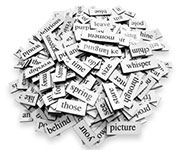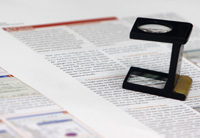On the job, or for one of the professional, civic, or social organizations we support, many, if not all of us will probably be asked at some point to “help get the word out” about a variety of things, ranging from a promotion or a new hire to an event at work, or not.
These simple announcements should be easy to write, almost formulaic, and they must be interesting enough to your chosen audience that he or she will read it. And, best case, pass the information along to others who will likewise be interested.
How do you do it?
1. To begin with, decide who you are trying to reach with your information, and how best to get this information to them. What do they read? Listen to? Watch? What meetings do they attend? Where do they hang out? In short, where are you most likely to find them?
These days, email and social media are good bets, along with the traditional media: newspaper, including the neighborhood or local papers; radio; and television. Again, depending on who you are trying to reach, professional publications, alumni magazines, and their respective websites could also work for you, as could presentations to a variety of organizations, or just plain “word of mouth,” inspired by personal phone calls or emails or…
2. Now that you know who you primarily want to get the word out to, and how you will reach them, you’ll need to find out the ground rules for each medium you plan to use. For example, most newspapers will have a business column, as well as a “calendar of events” where you will (respectively) send your announcements. These columns will also have deadlines for submission of your material. Also check professional publications and alumni magazines for their deadlines.
While it is highly unlikely that radio or television will use this type of story, some may have programs that will, so check into this as well.
With email you’ll want to determine how many times you will send an email on this subject, how often, and to whom. Then schedule your emails. Various social media outlets will have their own traditions.
3. Decide what information you want to include for each of the media you plan to use. While the easiest thing is to use the same “press release” for everyone, the format may be different depending on where the information is being sent. The information you include, however, will be the same.
For an announcement of a promotion or a new hire, you will want to include in the first paragraph who the person is (this may include a brief, powerful description if available, such as “Pulitzer prize winner, Dr. Joe Jones…” or a former position held, if appropriate); what happened (hired, promoted, or…); when; the name of the company or organization and location; and usually who is making the announcement.
Most likely, this will be the only information used, and it may be re-written.
The second paragraph will detail the individual’s new, or continuing responsibilities, and his or her qualifications for them, which may include previous positions, education, special training or certification, etc.
The third paragraph, in the standard “press release” format, will probably be a brief, standard description of the company or organization. This is also unlikely to be used, but may be helpful.
Of course, you may always hope that something in your information might lead to a more substantial story, but don’t hold your breath. Also, there is a possibility that, for whatever reason, the information may not be used at all, through no fault of your own.
For an event, you will obviously want to include the standard information: what the event is; where it will be held (including the address if not someplace familiar to readers) and when; the purpose; who is invited; and the appropriate details – how to purchase tickets, how to gain access to the venue, and so on.
Now, find your “grabber.” The first thing you say in the first paragraph. For an event, ask yourself, “What is most important – to the reader – about this event? Start there.
To receive your Business Writing Tip of the Week automatically every week, please subscribe to our newsletter. We appreciate your recommending a Gail Tycer business writing workshop for your workplace, or a shorter presentation for an upcoming professional meeting. Thank you.



 Remember the last time you started to install, or assemble, or repair something, following the appropriate set of manufacturer’s instructions – only to find that, while they included steps 2, 5, 6-8, 10, and 12 – they had forgotten to include steps 1, 3-4, 9, and 11?
Remember the last time you started to install, or assemble, or repair something, following the appropriate set of manufacturer’s instructions – only to find that, while they included steps 2, 5, 6-8, 10, and 12 – they had forgotten to include steps 1, 3-4, 9, and 11?



 “They seem to know what they’re doing,” might be one desirable judgment. “They sound like they’re easy to work with,” another. If, after reading your written communication, your reader were asked, “What do you think about (your organization)?” what do you want him or her to say? Isn’t there a bit of persuasion there?
“They seem to know what they’re doing,” might be one desirable judgment. “They sound like they’re easy to work with,” another. If, after reading your written communication, your reader were asked, “What do you think about (your organization)?” what do you want him or her to say? Isn’t there a bit of persuasion there?


